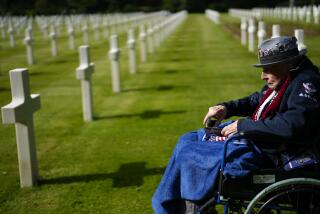Trip to Mine Fields Seen as Bettering U.S.-Vietnam Ties
- Share via
More than 20 years ago, in another time and distant place, U.S. Marines trudged through the monsoons, mud and shellfire of the killing fields of Vietnam.
Many just out of high school, they fought from Khe Sanh, where they withstood a bloody 77-day siege, to the streets of Hue, where emperors once sat, and Dong Ha, a dingy frontier town shelled so much the Marines called it “Rocket City.”
One battalion, the 11th Marines, 3rd Marine Division, helped plant about 100,000 land mines to protect a string of U.S. outposts along the 17th Parallel that then divided Vietnam into North and South.
Now, as the new year begins, six former Marines are going on a sentimental, bittersweet patrol into the past, to places halfway around the world once known on war maps as Cam Lo, Con Thien and Gio Linh, to walk again those battlefields of their youth and to look into the eyes of the once faceless enemy.
Hope to Verify Removal
Concerned that many of the mines they buried are still in place and still a threat, the former Marines are returning to try to verify Vietnamese statements that the explosives have been removed.
Gene Spanos, 39, now a Rosemont, Ill., police lieutenant, organized the mission.
Other former members of the 11th Marines making the journey are Frank Noe, 40, a Stoughton, Mass., fireman; Nate Genna, 41, of Boston, who works in the operations and maintenance department of a shopping mall; William Johnson, 41, of Manchester, Conn., an electric-sign maker; and Mike Wallace, 41, a farmer from Langdon, Kan.
Joining them is Robert Dalton, a 54-year-old free-lance writer from Davidsonville, Md., who served three tours of duty in Vietnam and speaks fluent Vietnamese.
They are scheduled to arrive Jan. 14 in Hanoi on a 10-day tour of Vietnam, reunified by the Communist-led Hanoi government of the North that toppled the U.S.-backed Saigon government of the South.
Familiar War Zones
From the country’s seat of government in Hanoi, they travel southward as friends instead of foes to familiar war zones such as Dong Ha, and Hue, capital of the Annam empire, established more than 200 years before Christ.
Even though the Vietnamese insist that they have cleared the mines and that the six Americans are visiting the country as tourists, their return symbolizes the further healing of wounds from America’s longest and most divisive war.
Vietnam has been opening its doors wider and wider, seeking to publicize its desire to establish diplomatic relations with the United States in a bid for economic aid and medical and technical assistance. Washington says that assistance will not be given until Vietnam removes all its troops from Cambodia, which Hanoi has promised to do by 1990.
The latest mission is a private one paid for by a benefactor whom Spanos will identify only as a wealthy businessman. Spanos said his group will submit its findings to both governments.
“They are welcome,” said Ambassador Trinh Xuan Lang, head of the Vietnamese mission to the United Nations. “They return without any animosity.”
‘Better Understanding’
In the last year, more than 60 American delegations have visited Vietnam, including veterans, congressmen, senators, scholars, journalists and tourists, Lang said. “These visits will contribute to better understanding,” he said.
The ex-Marines reconstructed mine field maps and gave them to the Vietnamese government last June. While in Vietnam, they want to go to the areas with their Vietnamese counterparts to take a firsthand look not only for land mines, but also for any unexploded bombs and shells dropped by U.S. forces.
The once gung-ho Marines, mellowed by time, hope to visit a Vietnamese veterans hospital filled with soldiers like themselves, and an orphanage crowded with malnourished children. They will carry medicine, badly needed by a medical system ravaged by five decades of war.
“I was bitter at that time,” Genna says of his combat days at Dong Ha from January, 1967, until January, 1968. “That whole war was wrong. Americans got killed and plenty of Vietnamese got killed. I’m not the 19-year-old kid I was then. This is a show of good will, people to people. We’re trying to establish one more step toward normalizing relations and increasing understanding between the two countries.”
Image of Veterans
Noe, who served 18 months in Vietnam, says the trip will help erase an already fading and unjustified image of Vietnam veterans as brutal killers who often aimed their shots at women and children. Many came home to rejection, spat upon and called “baby killers.” Some turned to drugs and alcohol.
“Men who once fought against each other can heal old wounds and sit down and maybe even talk about those days,” Noe said. “I think it will do us some good and them also. I think in this country it’s going to show Vietnam veterans aren’t what they’ve been portrayed over the years, that we’re firemen, police, from every walk of life, and do care about people.”
Hundreds of people, some of them veterans, have telephoned and written words of encouragement and praise.
Jacob Bell, 15-year-old son of another former Marine, wrote a poem for those going back. It reads in part:
So now a few, who represent us all,
Have heard the victims innocent call,
. . . Go for us, reach out a hand,
Let our country see how united we stand.
Wallace, who served as a medic with the 11th Marines, said: “We’re finding out it’s a reconciliation, a healing process, not only for veterans, but for their families. If you can redo some tragic part of life and replace it with good memories, it’s got to be therapeutic.”
The former Marines say they never planted the mines with the intention of hurting civilians, but rather to protect American lives. Barbed wire was placed around the mine fields with warning signs in Vietnamese and English. But after the war’s end in 1975, poor Vietnamese farmers and scavengers apparently dismantled the valuable barbed wire, exposing the mine fields.
Lang says all of the mines have been removed at the cost of thousands of civilians killed, particularly during the three years after the end of the war when land was being cleared for farming and housing.
Children Wounded by Mines
Spanos says other veterans who visited Vietnam in recent years reported seeing children in hospitals who had been wounded by mines and unexploded shells.
Spanos got the idea for the good-will mission at the 11th Marines’ first reunion in Chicago in September, 1987, after reading an article in the Boston Globe. H. D. S. Greenway reported that he was told that more than 3,000 Vietnamese had died in one province alone from mines and unexploded shells between 1975 and 1985.
Spanos’ reaction was: “God almighty, if we’re still killing these innocent people, we’ve got to do something. Let’s go back.”
Although the former Marines are not so sure, Dalton, who has made three previous trips to Vietnam in the past two years, says he is convinced that the mines have been removed in the northern areas, although he cannot be as certain about other sections of the country.
“I think it will be a very good thing not only for the Marines to go back to close the door on past operations in their mind, but also to allow the Vietnamese who suffered in clearing these mine fields to see the Americans return fully prepared to help them,” Dalton said.
300,000 Disabled by War
A 1987 report compiled by the U.S. State Department based on estimates provided by Vietnamese government and other sources said more than 300,000 people in the country were disabled by the war, including 15,000 amputees between 7 and 15 years old.
Further illustrating the desperate plight of the Vietnamese, officials estimate that half of the country’s children are malnourished.
The U.S. government is forbidden by law to provide assistance to Vietnam but has tried to make it easier for individuals and organizations to send humanitarian aid.
More to Read
Sign up for Essential California
The most important California stories and recommendations in your inbox every morning.
You may occasionally receive promotional content from the Los Angeles Times.










